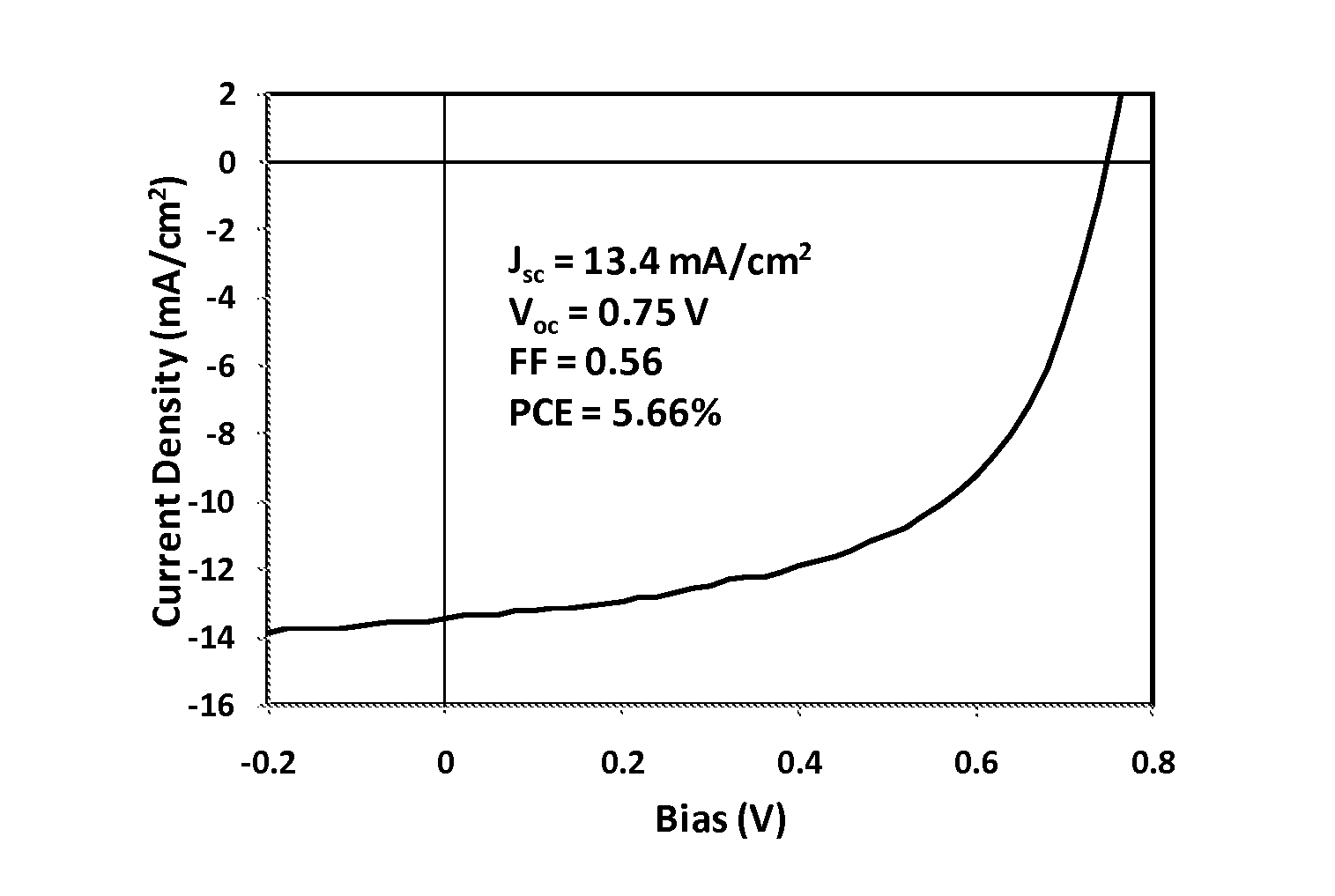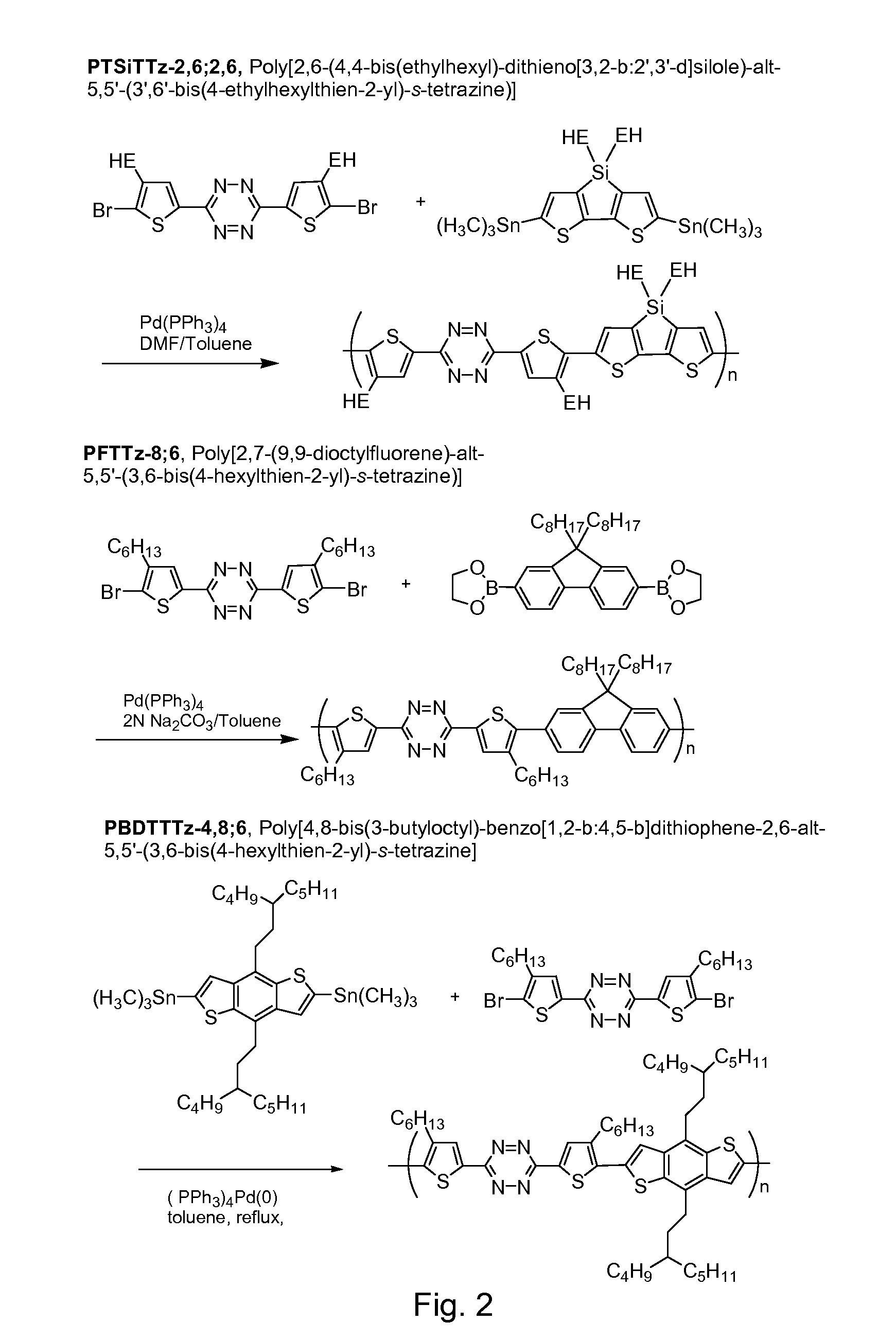Tetrazine monomers and copolymers for use in organic electronic devices
a technology of organic electronic devices and tetrazine monomers, which is applied in the direction of non-metal conductors, conductors, organic chemistry, etc., can solve the problems of 4.9 ev, the highest occupied molecular orbital energy level at 4.9 ev, and the value already seems to be an upper limit, so as to reduce the homo and lumo energy levels of the copolymer. , the effect of high crystallin
- Summary
- Abstract
- Description
- Claims
- Application Information
AI Technical Summary
Benefits of technology
Problems solved by technology
Method used
Image
Examples
example 1
Synthesis of 3,6-bis[5-bromo-4-(2-ethylhexyl)thien-2-yl]-s-tetrazine monomer
4-(2-Ethylhexyl)-2-thiophenecarboxaldehyde
[0051]3-(2-Ethylhexyl)-thiophene (19.6 g, 100 mmol) and anhydrous tetrahydrofuran (250 mL) were charge into a 500 ml flask. The solution was cooled to −78° C. with dry ice / acetone. N-butyl lithium (40 mL, 2.5 M in hexane, 100 mmol) was dropped into the solution. After addition, the reaction solution was warmed to room temperature and stirred for 30 min. Then, the solution was cooled to −78° C. again and 1-formylpiperidine (13.6 g, 120 mmol) was added in one shot. The reaction solution was allowed to warm slowly to room temperature and stirred at room temperature for overnight. The solution was acidified with hydrochloric acid (2 N) and then extracted with ether (2×100 mL). The organic extracts were combined and washed with distilled water (2×100 mL), dried over anhydrous magnesium sulfate and rotary evaporated to remove the solvent. The residue was run through a sili...
example 2
Synthesis of PTSiTTz-2,6;2,6 copolymer
4,4′-Bis(2-ethylhexyl)-5,5′bis(trimethylstannyl)-dithieno[3,2-b:2′,3′-d]silole
[0055]4,4′-bis(ethylhexyl)-dithieno[3,2-b:2′,3′-d]silole (1.17 g, 2.79 mmol) was added into a 50 mL flask and purged with Ar under vacuum. 20 ml of dry THF was added into a flask. The solution was cooled down to −78° C. using a dry ice-acetone bath. Then 1.6 M n-butyllithium / hexane solution (3.84 mL, 6.14 mmol) was added dropwise. The temperature was then raised to about room temperature and the solution was stirred for 60 minutes. The solution was cooled to −78° C. again, and 1M trimethyltin chloride / THF (6.98 mL, 6.98 mmol) was added. Then the cooling bath was removed. After being stirred at ambient temperature overnight, 20 mL hexane and 20 mL of H2O was added with stirring, the water layer was separated, the organic layer was washed with 15 mL of H2O again, and the combined water layers were extracted with 20 mL of hexane. The combined organic layers were washed wi...
example 3
Synthesis of 3,6-bis(5-bromo-4-hexylthien-2-yl)-s-tetrazine monomer
4-Hexylthiophene-2-carbonitrile
[0057]A mixture solution of 4-hexylthiophene-2-carbaldehyde (11.8 g, 60.0 mmol) and hydroxylamine hydrochloride salt (6.3 g, 90 mmol) in pyridine / ethanol (60 mL, 1 / 1 v / v) was stirred at 80° C. overnight. Then the solvent was removed and the residue was dissolved in chloroform (100 mL). The solution was washed with distilled water (2×50 mL) and dried over anhydrous magnesium sulphate. The solvent was removed and the viscous liquid residue was refluxed in acetic anhydride (30 mL) containing potassium acetate (0.2 g) for 3 h. Then the mixture was poured into distilled water (100 mL) and extracted with hexanes (3×50 mL). The combined organic phase was washed three times with water (50 mL), dried over anhydrous magnesium sulfate before the solvent was removed by rotary evaporation. The yellow liquid residue was purified by silica-gel column chromatography (EtOAc / hexane=7 / 93, v / v, Rf=0.4) to ...
PUM
| Property | Measurement | Unit |
|---|---|---|
| Mass | aaaaa | aaaaa |
| Mass | aaaaa | aaaaa |
| Mass | aaaaa | aaaaa |
Abstract
Description
Claims
Application Information
 Login to View More
Login to View More - R&D
- Intellectual Property
- Life Sciences
- Materials
- Tech Scout
- Unparalleled Data Quality
- Higher Quality Content
- 60% Fewer Hallucinations
Browse by: Latest US Patents, China's latest patents, Technical Efficacy Thesaurus, Application Domain, Technology Topic, Popular Technical Reports.
© 2025 PatSnap. All rights reserved.Legal|Privacy policy|Modern Slavery Act Transparency Statement|Sitemap|About US| Contact US: help@patsnap.com



